Design’s Impact on Seniors’ Perceptions
of Wellness

Danya Hakky PhD


Danya Hakky PhD
Perkins Eastman is a global architecture firm dedicated to the idea that design can have a direct and positive impact on people’s lives. For almost forty years, our senior living experts have shared a passion for research and design that focuses specifically on improving the quality of life and level of care of older adults. We create places and spaces that put the user at the heart by employing best practices, sustainability, and a thorough understanding of our clients’ missions and operations. Our diverse teams partner with our clients globally to deliver next-generation projects suited to users who will live, work, play, learn, age, and heal within the environments we plan and design.
©2020 Perkins Eastman. All rights reserved.
In 2020, the COVID-19 pandemic upended most senior living communities in the United States, as people’s safety and controlling the spread of the virus became paramount. Dining venues have closed, classes moved online, family visits are held virtually, social interactions decreased and when they do occur in-person they are at a distance. An industry focused on creating healthy communities has suddenly had to reevaluate how to help their residents and staff to remain physically, socially, and emotionally well.
Early media in the Spring and Summer of 2020 challenged the senior living sector and painted it with a broad brush, given the difficult death statistics reported by nursing homes and some assisted living communities. Headlines asked why anyone in the future would move to a senior living community due to the innate risks of group living conditions. Further, the headlines yet to be written may be about the isolation and failing health of older adults living on their own without formal or informal support networks that help them to thrive (e.g., family support, visiting care givers, meals, health checks, etc.). Loneliness and depression are major health concerns for aging adults. We have yet to fully understand how isolation due to the COVID-19 pandemic is impacting the emotional and physical health of this vulnerable population.
This study, “Design’s Impact on Seniors’ Perceptions of Wellness,” began years before we saw COVID-19 appear as a major disruptor in 2020. Our goal with this study was to understand how older adults living in senior living communities would evaluate their own physical, social/ emotional, and intellectual wellness. Over 540 people in three west coast communities shared their perceptions of how environmental design strategies supported their personal wellness. Over 90% of the study’s participants felt that the design strategies employed in these communities were integral to their well-being.
As we fight through the pandemic and enter a post-COVID world, we will continue to seek to understand how design
impacts wellness, and how we can affirm why older adults would choose a senior living community over staying at home. It is clear that some design strategies may alter or be temporarily altered in times of infection, but it is also clear how valuable these strategies are for creating a path for healthy aging.
We present this paper knowing that, though this study was conducted before COVID-19 hit the shores of the United States, what we learned in this pre-pandemic study and what we are learning now (and in the months and years to come) about how senior living communities help residents and staff to remain physically, socially, and emotionally well will influence how we understand the impact of design moving forward. Combined, this information offers a hopeful future for design’s impact on seniors’ perceptions of wellness.
We present this paper knowing that, though this study was conducted before COVID-19, what we learned through this research—and what we are learning now through the pandemic—about the impact of design will help residents and staff of senior living communities to remain physically, socially, and emotionally well.
At Perkins Eastman, we rely on our collective expertise, extensive research, and stakeholder engagement to create environments that enhance people’s quality of life. We apply this approach to all our projects, including three senior living communities we worked with who have a strong commitment to resident wellness and health. Along with meeting all the practical needs of the projects, our design teams applied different strategies to leverage the built environment’s positive influence and to create places that enrich residents’ wellness.
Our research team, working closely with the projects’ designers, studied the impact of the design decisions on residents’ perceptions of wellness. We focused on three dimensions of wellness1 which have the potential to greatly impact residents’ quality of life: physical, social/ emotional, and intellectual wellness. As lifelong learners, we sought the opportunity to dig deeper—to evaluate our successes, learn from our work, and grow our abilities in delivering high quality environments for our clients and their stakeholders.
We knew a true evaluation of success could only come by including the residents themselves—the people at the center of our designs and strategies. Thus, we endeavored to formally collect feedback, by way of resident questionnaires, to supplement the anecdotes we were hearing and our informal observations with hard data

from the three sites. Primarily, we wanted to understand whether intentional design strategies intended to promote whole-person wellness positively contributed to residents’ perceptions of wellness in their new environments.
After introducing the study and the three participating communities, this report shares the overarching strategies purposefully employed by the designers to support wholeperson wellness. This is followed by a summary of findings on how residents’ perception of wellness may have been influenced by the design strategies used. Finally, the report ends with closing thoughts and a matrix presenting the strategies and the aspects of wellness each may influence when applied to the built environment.
We wanted to understand whether intentional design strategies intended to promote whole-person wellness positively contributed to residents’ perceptions of their personal wellness.



This report focuses on three not-for-profit senior living communities designed by Perkins Eastman that have undergone either new construction and/or renovations with the purpose of, among other things, supporting their residents’ holistic wellness.
Located in Altadena, CA, this non-profit senior living community takes full advantage of the stunning landscape and Mediterranean-like climate of the greater North Los Angeles area with its outdoor spaces and bright indoor areas. MonteCedro looks to inspire its residents to lead creative, aspirational, and fulfilling lives through its innovative programming and holistic approach to wellness.
Tucked in the picturesque Sonoma Valley, Santa Rosa, CA, this senior living community offers a variety of living choices including apartments and cottages. Perkins Eastman was tasked with planning a campus expansion for this community to add 62 new independent living homes as well as renovate the Village Center. The renovation and construction were completed in multiple stages and achieved LEED Silver.
Situated in Spokane, WA, Rockwood provides a variety of independent living, assisted living, and skilled nursing residences and services for seniors. Rockwood’s forwardthinking leadership runs a Livewell program: a holistic approach to wellness that focuses on physical activity, healthy diets, vocational training, spiritual growth, and educational programs. Perkins Eastman reimagined the existing Ridge Tower and designed the new Summit building, with 65 new independent living apartments
Perkins Eastman was engaged to support this vision through planning and design services, including purposful common areas, 184 living residences along with memory support and in-home services.
The design incorporated a mix of flexible spaces that were meant to encourage residents to pursue art, physical activity, self-care, intellectual growth, and entertainment.
The design added and relocated favored amenity spaces, providing spatial configurations that blurred the boundaries between indoor and outdoor spaces. Based on resident interest, amenities were enhanced to increase residents’ holistic wellness, including; an auditorium, state-of-the-art fitness center, heated pool, and library. Additionally, a new bistro-style dining area offers flexibility on when and what to eat, a welcomed new amenity that is often heavily used and full of life.
and abundant activity and social spaces for the entire community.
The design was initiated and completed at a time when the concept of whole-person wellness was at its infancy within the senior living industry. Inspired by Rockwood’s leadership, Perkins Eastman’s designers were eager to deliver on wellness through building design as well as push the envelope further by applying their pioneering knowledge and application of Biophilic design principles.


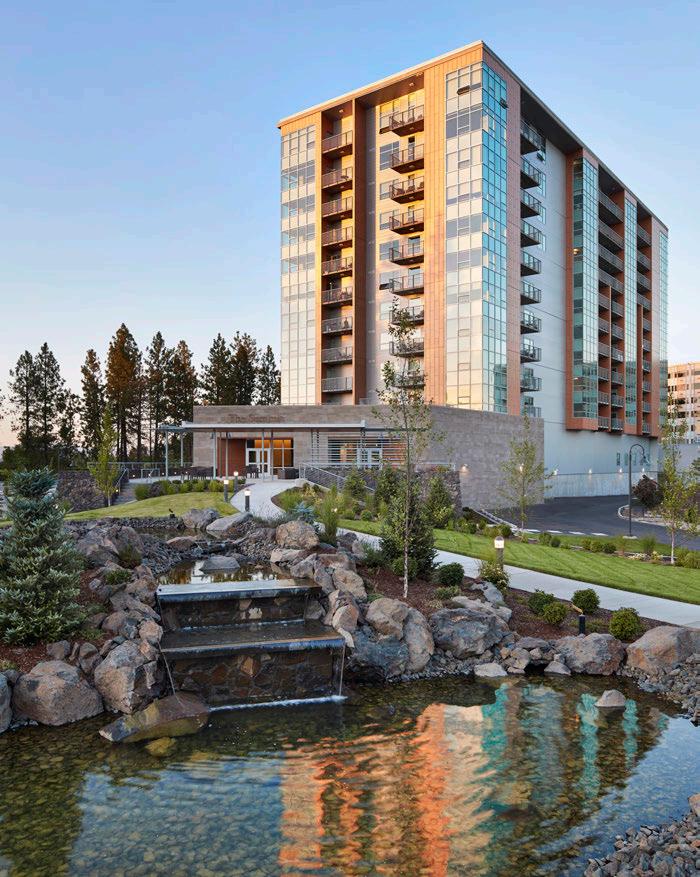

Pre-occupancy evaluation (PreOE) and post-occupancy evaluation (POE) data were collected via resident questionnaires in 2015-17 at three senior living communities. These sites were selected because their project goals focused on whole-person wellness and specific design strategies were incorporated into the projects to support this objective. In sum, 381 residents participated at pre-occupancy stages across two sites (222 at Spring Lake Village2 and 159 at Rockwood Retirement Communities) while 543 residents participated in post-occupancy stages across three sites (106 at MonteCedro, 232 at Spring Lake Village, and 205 at Rockwood Retirement Communities).
381 residents participated at pre-occupancy stages across two sites and 543 residents participated in post-occupancy across three
Residents responded to questionnaires at strategic points in the design process: before construction (PreOE) and after construction and occupancy (POE). The timing of each questionnaire offered different insights and lessons learned. For example, at MonteCedro, residents were involved in a post-occupancy questionnaire six months after project completion, which captured people’s evaluation of spaces after the move-in adjustment period was over. On the other hand, Spring Lake Village went through two stages of building additions and renovations that allowed two post-occupancy evaluation surveys. These evaluations fell two years apart and helped explore the sustained impact of design on residents’ perceptions of wellness. At the third site, Rockwood, both pre- and postoccupancy questionnaires were administered. Together, pre and post surveys established a reference point that charted the design’s progress at supporting the multiple aspects of wellness.

Many senior living communities have, in recent years, shifted their focus to whole-person wellness by intentionally guiding residents to engage in activities, socialize, exercise, and pursue intellectual growth, among other holistic endeavors. Oftentimes, however, communities have a good mix of programs to support this vision, but lack the right spaces to inspire and support
such pursuits. Designers have been responding to this discrepancy by applying a variety of design strategies to the architecture and interiors of buildings that allow them to better encourage and support whole-person wellness initiatives. There is a large array of strategies designers use; the following is an over-arching look at some.











Autonomy + Control
Feelings of autonomy and control are some of the psychological factors crucial for building a sense of home particularly for an older population.3
There are many levels of autonomy and control that residents require. Providing options, variations, and flexibility through design can help address this. For example, seating arrangements
suitable for both individual use and for social gatherings allow residents to choose their desired level of connection and interaction with others. Another example is providing indoor, outdoor, and in-between seating areas to give residents control over their degree of connection to the natural environment.
1. The library space at MonteCedro offers a variety of seating options suitable for residents to either sit individually with a book, or huddle around a table for a conversation or activity. 1



2. The indoor dining area at MonteCedro spills out onto an exterior porch giving residents a comfortable seating option for enjoying their meals in the fresh air on fair weather days.



Activities can be split into two categories: individual and social. They may occur passively (e.g., individual: people watching/contemplating, social: attending the theatre) or actively (e.g., individual: exercising by oneself, social: playing
card games in a group). They can occur both indoors and out, or even somewhere in between. Successful communities provide a variety of flexible spaces that can accommodate a wide range of activities.



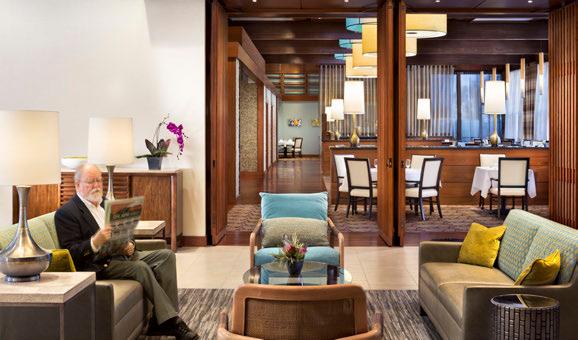




Promoting use through location and access
Perceiving that spaces are easy to reach and accessible is paramount for residents to use them often. Both a space’s location within the overall community and within a building affect people’s feelings of access, as does entrance orientation and visual connections.
5. At Spring Lake Village the fitness center and swimming pool were relocated to the front of the community to increase their access by everyone.
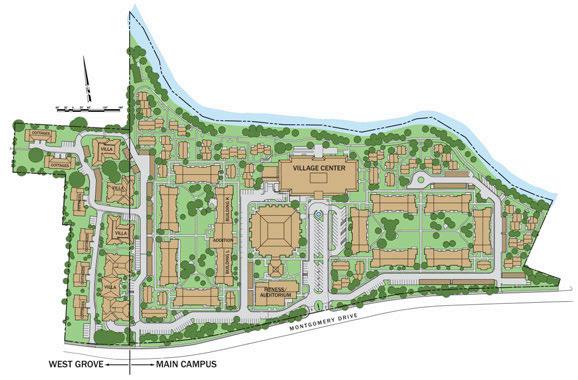


6. The Summit, a new building at Rockwood, was intentionally oriented towards the rest of the community to draw people into its amenity spaces.
7. The indoor pool, a feature typically hidden behind solid walls, was promoted at Spring Lake Village by wrapping circulation around it and providing visual access through floor-to-ceiling glass. Residents seeing the sunlit space with its refreshing water and outdoor views may be encouraged to get in a workout or leisurely swim.





Residents may move about a space in either a targeted manner (i.e., traveling from point A to B) or a more leisurely mode (e.g., enjoying the views, looking for social opportunities).
Successful circulation patterns offer the most
convenient routes for targeted movement as well as pleasant routes that can informally bring people together and encourage them to engage with others or with the activities going on around them.








8. By placing two major activity spaces at MonteCedro—the auditorium and theatre— at either end of the main circulation spine, people are brought together and encouraged to congregate after attending an event. The open dining area and lobby with abundant seating is anchored between the two locations offering a place for conversations to continue after an event, rather than attendees splitting up and going straight home to their private residences.
9. Circulation at Rockwood winds and curves within the Summit building, opening up in strategic locations into different areas, drawing attention to a game room, dining area, or library. Walking along the path, residents who spot something of interest may be encouraged to join in on an activity, increasing their chances of maintaining social/ emotional, physical, and intellectual wellness.

Natural environments offer multi-sensory experiences5 and many benefits to cognitive,6 emotional, and physical health. Buildings can provide residents with opportunities to engage with nature either passively through their five senses (i.e., viewing, hearing, smelling, touching, and feeling) or actively through movement
and activity (e.g., walking, running, gardening, contemplating).
Further, aspects of the natural environment can be brought into the interior environment through applying principles of Biophilic Design.
11.
residents can play games during the day or sit around a fire under a starry sky, brings people together to enjoy the benefits of the outdoors.
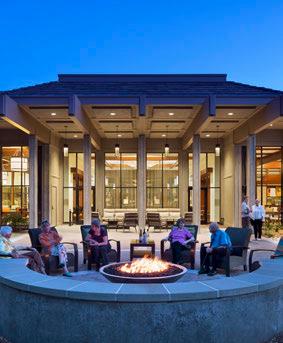





12. Shaded paths at Spring
provide a place for leisurely walks while connecting the community.
13. Designers at Rockwood applied various Biophilic principles4 in their design, including the use of natural materials, motifs, patterns, and color palette






Creating spaces that foster unplanned, serendipitous opportunities to meet others and see occurring activities can help the
development of meaningful relationships and increase chances of residents partaking in the community’s programs.






14. MonteCedro’s designers chose to place one of its dining spaces away from the building’s isolated corners, opting to locate it instead in the center of the building’s plan with the main circulation running through it. This design strategy maximizes visual exposure, allowing residents to serendipitously spot and join friends for a meal or chat.
15. Rockwood’s living room opens up on its winding interior corridor and is set-up with games, reading chairs, and comfortable sofas for intimate conversations. Residents walking by can spontaneously connect with a friend or create a new acquaintance

Degrees of privacy are important for individual growth and relationship development. Cozy corners are ideal for (e.g.) losing oneself in a book or having a conversation with a friend.
Open, visually connected spaces are great for both planned and chance interactions and relationship building.
17. At Spring Lake Village, a flexible prefunction Creekside Lounge was added, nestled between the Great Room and the Sonoma Room for fine dining. Its location, along with operable partitions, allow it to be made both private and public, based on the occasion. The room invites people entering or leaving either the Great Room or Sonoma Room to easily and opportunely join in on functions and social events, while offering those seated in it a warm and intimate spot to converse. Degrees
16. Partitions of different heights and transparency were used along Rockwood’s circulation path to offer varying degrees of openness and enclosure. Based on one’s comfort level or mood, residents can continue walking along the path, choose a location that is highly visible and convenient for seeing and being seen, or select a private and quiet area suitable for (e.g.) a conversation, reading a book, or playing a game of chess.






Light, especially daylight, is a powerful element that can create dramatic changes to the feel of a space. For instance, washing spaces with unobscured light fills them with a dynamic energy, whereas filtering light through swaying tree leaves creates a calm and soothing effect. These variations in ambiance can draw people
to spaces and increase their engagement in the activities offered therein. Along with affecting ambiance, daylight can also influence residents’ health, and well-being. Providing access to appropriate levels of daylight allows residents to harness its benefits and avoid the negative effects of over-exposure.
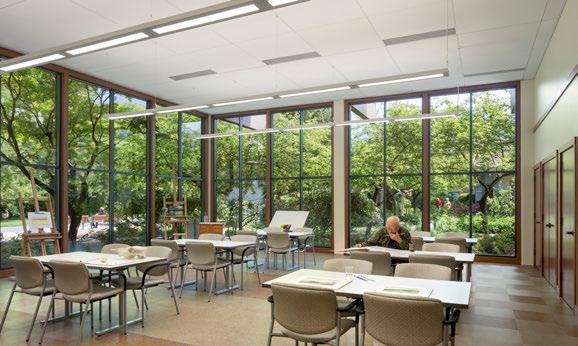






floor-to-
windows
bring in abundant light filtered through tree branches. The indoor environment melts into the outdoors creating an inspirational area for residents to explore the arts, increasing their intellectual and emotional wellness.
Residents
benefit from access to direct daylight, either lounging by the pool in the full sun or under an umbrella to ensure they avoid over-exposure.

Engaging the senses through intangible elements, such as pleasant fragrances and sounds, can help increase wellness in different ways. For example, lavender can calm and relax people,7 cinnamon can enhance cognition,8
and the smell of fresh-baked bread around meal times in combination with other methods contributed to a 5% reduction in seniors’ malnutrition in one study.9
20. The kitchen at the Spring Lake Village Bistro opens directly into the dining area, filling it with enticing smells of favored foods.
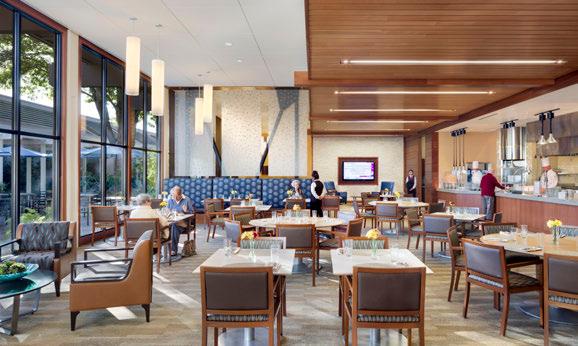

21. A gentle waterfall feature evokes the Spokane River and it’s falls, with rays of light breaking on the water’s rippling surface and the sound of water softly falling and bouncing off stones, greets residents as they enter the Summit at Rockwood, providing a rich sensory experience that can evoke happy memories for some residents or help create new pleasant ones for others.


Conjuring the indefinable sense of comfort that comes with homey or vernacular design features can de-institutionalize a building, evoke positive memories, and relax or invigorate people. In a non-institutional environment, residents may be less likely to retreat and isolate themselves,
taking advantage instead of the holistic wellness programs offered and building relationships with others. This is particularly important for residents transitioning from a home they had spent many years in among neighbors they’ve known for long periods of their life.



carefully preserved some of the furniture pieces in the
while breathing
life into the
space, maintaining its familiar, homey character and importance to the residence.

Analysis of the pre- and postoccupancy evaluations from the three participating communities is summarized next, highlighting residents’ perceptions of the built environment and how it may have supported aspects of their whole-person wellness.

Many factors contribute to people’s physical wellness including the built environment, which was said to provide “good” to “excellent” support at MonteCedro by the majority of residents (94%). Despite residents mostly indicating “no change” to specific aspects of their physical wellness, this is actually a notable achievement. MonteCedro’s residents are described as individuals who have been energetic and active their entire lives, so for them to cite no change is a testament of a design that helps sustain their lifestyle and physical activities despite the challenges of moving to a new environment. Furthermore, the survey showed that residents felt some aspects, such as access to physical-wellness resources and exercising regularly, were “better” after moving to MonteCedro (46% and 37% of residents, respectfully). The airy and inviting design of the fitness center and swimming pool, for instance, may have contributed to this increase in perceived physical wellness.
94% of respondents said the built environment at MonteCedro provides “good” to “excellent” support of physical wellness
general physical wellness
eating regularly
eating a balanced diet of healthy foods
exercising regularly (at least 3X per week) (such as walking, attending fitness classes, swimming, etc.)
quality of sleep
ability to accomplish activities of daily living
(such as dressing, bathing, grooming, etc.)
quality of sleep
getting routine medical checkups
(such as taking medicines as directed,
ability to accomplish activities of daily living (such as dressing, bathing, grooming, etc.)
getting routine medical checkups
complying with medical orders (such as taking medicines as directed, doing prescribed physical therapy, etc.)
having access to physical wellnessrelated resources/support services
(positive impact) No Change (positive impact) Worse not shown


In terms of social/emotional wellness, the design team aimed to improve this aspect of wellness by creating environments that would help build a sense of community among residents. Responses from the POE were encouraging, as almost 60% of residents indicated MonteCedro feels like one community regardless of where someone lives on the property. Additionally, almost everyone (93% of residents) indicated they developed new relationships at the community, while many (75% of residents) maintained their network of friends and community engagement after their move into the senior living community. Attending activities and programs that fit many individuals’ interests (88% of residents) could have been one way new relationships developed. Another may have been the casual dining area, which 88% of residents thought provided “good” to “very good” opportunities for socializing—almost double the 45% of residents who thought the Fine Dining area provided that support.
Similar to physical wellness, a slight majority reported “no change” to specific aspects of social/emotional wellness, however it seems the purposeful design for social interactions may have helped residents feel they had “better” access to social/emotional wellness related resources/support services, a well-developed support system, and feeling a sense of connection/ belonging (49%, 46%, and 43% of residents, respectfully). Considering the challenges of moving to a new home, particularly at a later stage in life, it is notable that residents’ social/emotional wellness either improved or held steady, and any “worsening” was noted by no more than 1–2% of residents.
92%
92% of respondents said the built environment at MonteCedro provides “good” to “excellent” support of social/emotional wellness.
88%
45%
88% of residents thought the Off Lake Bistro casual dining option provided “good” to “very good” opportunities for socializing—almost double the 45% of residents who thought the Fine Dining area provided that support.
general social/emotional wellness
feeling a sense of connection/belonging having
Better (positive impact) No Change (positive impact) Worse not shown

24. Variety of dining venues including the fine dining option (right) provide opportunities for socializing and connecting with others.

Specific aspects of intellectual wellness saw improvement according to the majority of residents. This is most notable in the percentages of respondents who found improvement in their access to intellectual wellness-related resources, opportunities to expand or challenge knowledge and skills, and opportunities to explore the creative arts (69%, 62%, and 58% of residents, respectfully). This can likely be attributed to the creative and dedicated programing at MonteCedro that is supported by the design of the built environment, which includes Ted Talks and creative endeavors. Jointly, the spaces and programing likely contributed to results in the POE showing 95% of participants indicated the built environment provides “good” to “excellent” support for their intellectual wellness.
95% of respondents said the built environment at MonteCedro provides “good” to “excellent” support of intellectual wellness.


In both rounds of surveys, residents thought the built environment provided “good” to “excellent” support of their physical wellness (84% and 94% of residents, respectfully). Specific aspects of their personal physical wellness did not see much change according to the majority of residents, while a very small percentage indicated that a few aspects worsened. This decline, however, is likely due to personal factors (e.g., a natural result of aging) as opposed to the design of the built environment.
Other aspects of physical wellness saw improvement, however. Most relevant to the built environment was residents’ evaluation of their access to physical wellnessrelated resources/support services. The first survey was conducted after the relocation of the fitness center and swimming pool, complete with aquatic programs, to the front of the community and the addition of the new Auditorium Building (Montgomery Center), making these buildings accessible to everyone, which may have contributed to 40% of residents reporting their access to physical wellness-related resources was better than it had been. In the second survey, conducted two years later, that percentage increased to 58% (a difference of +18%) which may have been helped by residents settling in, establishing a routine and taking advantage of purposeful programming offered by the community. In fact, residents also reported in the second survey that they exercise more regularly (at least three times per week) an increase from 25% in the first survey to 32% in the second (a +7% difference).
Support of physical wellness improved from 84% in the first survey to 94% in the second.
quality of sleep
general physical wellness
eating regularly
eating a balanced diet of healthy foods
exercising regularly (at least 3X per week) (such as walking, attending fitness classes, swimming, etc.)
quality of sleep
ability to accomplish activities of daily living (such as dressing, bathing, grooming, etc.)
getting routine medical checkups
ability to accomplish activities of daily living (such as dressing, bathing, grooming, etc.) complying with medical orders (such as taking medicines as directed, doing prescribed physical therapy, etc.)
getting routine medical checkups
having access to physical wellnessrelated resources/support services



Having a strong sense of community can improve social/ emotional wellness, and was therefore one of the project goals and items surveyed. About a third of respondents to the second survey said Spring Lake Village feels like one community regardless of where one lives on the campus. However, a little over half indicated they knew those who live closest to them best. Programmatic efforts to overcome physical distances could help residents get to know more people regardless of where they live. The new Bistro, for instance, was designed to play such a role, offering casual dining options and areas for people to socialize with friends, both new and old.
Renovating the main entrance to the Village Center, including the outdoor fountain and seating to draw residents into the center, was another strategy the designers employed to increase social/emotional wellness. It appears residents appreciated this and other design strategies that support social/emotional wellness because in the first survey, 83% thought the built environment provided “good” to “excellent” support for their social/ emotional wellness, which increased to 92% in the second survey (a difference of +9%). Despite changes to their lifestyles and routine, social/emotional aspects of wellness did not change for the majority of residents. A very small percentage of residents in the first survey thought some aspects were slightly “worse”, but this percentage decreased in the second round of surveying. Nonetheless, other aspects of social/emotional wellness were perceived as “better,” most notable was having access to social/ emotional wellness related resources/support services (36% in the first survey, increasing to 48% in the second survey—a difference of +12%), having a well-developed support system (28% increasing to 39%, +11%), creating and maintaining satisfying relationships (25% increasing to 35%, +10%) and feeling a sense of connection and belonging (+9% increase in the second).
Support of social/emotional wellness improved from 83% in the first survey to 92% in the second.
general social/emotional wellness
feeling a sense of connection/belonging
having a well-developed support system
coping effectively with life creating and maintaining satisfying relationships
having access to social/emotional wellness-related resources/ support services
28. View into Dining Area with its warm wood and comfortable furniture encourages people to spend longer times at meals eating and socializing.


Both rounds of surveys indicated residents felt that the built environment provides “good” to “excellent” support for their intellectual wellness (81% of residents in the first survey, increasing to 92% in the second survey, a difference of +11%). However, the results of the second survey differed from the first in that the latter had a slightly lower percentage of respondents who indicated that aspects of their intellectual wellness saw “no change” and a slightly higher percentage who indicated that aspects of their intellectual wellness were “better”. Most notable was access to intellectual wellness-related resources/support services, which was perceived as better by 56% of residents in the second survey (+11%). Design strategies, like adding technologies to the library that make accessing its resources easier and intuitive, may have been one way the design helped. Similarly, opportunities to expand and/or challenge knowledge and skills was said to be better by 47% of the residents in the second survey (+8%), as was having the opportunity to explore the creative arts (+6%), which may have been the result of a flexible and inviting design that supports a range of desirable programing.
Collectively, the pre- and post-occupancy surveys showed that the improvements to wellness that were documented in the first survey were either sustained or improved with time, as demonstrated by the data collected by the second survey.
Support of intellectual wellness improved from 81% in the first survey to 92% in the second
29. Group and individual seating in this activity room allow residents to explore and expand their skills, knowledge and art.

range of events, shows and lectures.



The new building, The Summit, was intentionally reoriented by the design team towards the overall larger community by changing the main entry location, to encourage everyone to venture into its amenity spaces, expanding it substantially. This ease of access, along with a substantially expanded program, may have contributed to more residents in the POE (+13%) indicating that the new building supported their physical wellness. Complying with medical orders and getting routine check-ups was also rated highly by 97% and 96% of participants respectfully (+13% in the POE compared to the PreOE), as was eating regularly and eating a balanced diet of healthy foods (+7% and +5%, respectfully). A sustained and slightly improved diet may have been a result of the new building providing more dining venues, which offer greater choices and an appetizing atmosphere.
To decrease dead-ends and increase opportunities for movement, dining venues were intentionally designed to lead into one another creating engagement zones. Moving along the “Riverwalk” circulation spine with its visual and physical access into spaces, may have also helped boost participation in community activities, such as social events/gatherings, dining outside of one’s residence, and attending education and fitness classes. In the first three categories, the percentage of participation “a few times a week” almost doubled, while attending fitness classes “once a day” increased by slightly more than double what it was at pre-occupancy (i.e., 5% in the PreOE
In the Pre-OE, 81% of residents thought the building provided “well” to “very well” support for physical wellness, compared to 94% in the POE, +13%.
increased to 13% in the POE). This may be a testament to a transparent and open design that encourages people to move around as well as being able to peruse the programs being offered.
Implementing Biophilic design principles may have also contributed to increased participation in activities as the spaces now provide abundant daylight and stunning views to the outdoors, making them more inviting. In fact, 46% of residents reported that they lingered longer in the new amenity spaces and dining venues, 62% said they appreciated the choice of amenity spaces and 68% appreciate choice of dining venues.
quality of sleep
general physical wellness
ability to accomplish activities of daily living (such as dressing, bathing, grooming, etc.)
eating regularly
eating a balanced diet of healthy foods
exercising regularly (at least 3X per week) (such as walking, attending fitness classes, swimming, etc.)
quality of sleep
ability to accomplish activities of daily living (such as dressing, bathing, grooming, etc.)
getting routine medical checkups
(such as taking
getting routine medical checkups
complying with medical orders (such as taking medicines as directed, doing prescribed physical
having access to physical wellnessrelated resources/support services

Social events/ gatherings
Dining outside your residence
Educational/specialinterest classes/programs
Wellness/fitness classes/programs
Around 46% of residents reported that they lingered longer in the new amenity spaces and dining venues.
62% of residents said they appreciate the choice of amenity spaces.
68% of residents said they appreciate the choice of dining venues.

Aside from contributing to physical health, attending events more often and lingering in common areas may have had a positive impact on residents’ social/emotional wellness. In fact, the POE indicates that residents’ social/ emotional wellness improved, going from 73% of residents who thought the building provided support that was “well” to “very well” in the PreOE to 93% in the POE. More specific measures of different aspects of social/emotional wellness also improved. For example, residents’ feelings of connection and belonging saw a positive increase (82% of residents in the PreOE thought their sense of connection and belonging was “good” to “very good” compared to 93% at POE, +11%) as did having a well-developed support system (78% indicated it was “good” to “very good” compared to 88%, +10%). This is arguably no small feat considering the difficulty people often face when adapting to a new space and community.
general social/emotional wellness
feeling a sense of connection/belonging
The POE indicates that residents’ social/emotional wellness improved, growing from 73% of residents who thought the building provided “well” to “very well” support in the PreOE to 93% in the POE.
social/emotional wellness
having a well-developed support system coping effectively with life
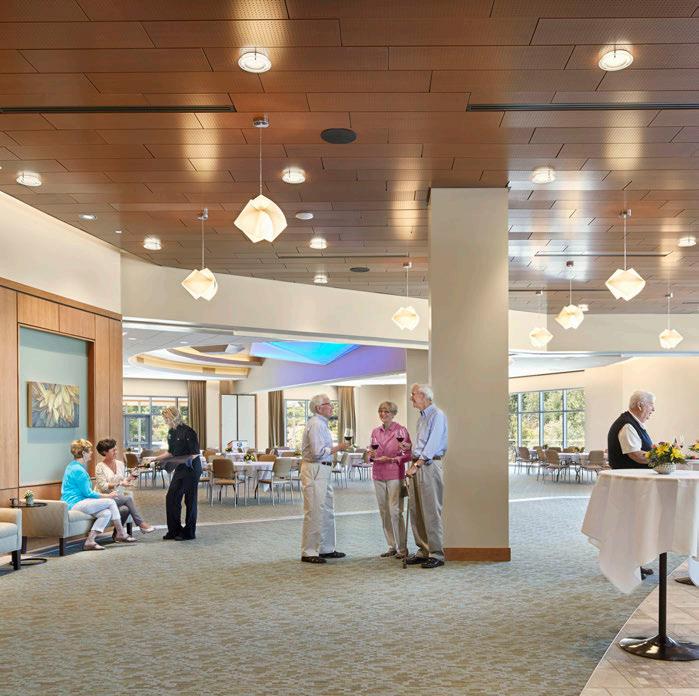

Easy access to a variety of spaces may have also contributed to more residents indicating the spaces provided support of their intellectual wellness that is “well” to “very well” (61% of residents in the PreOE compared to 91% in the POE, a difference of +30%). Reports of residents feeling that the environmental support for overall intellectual wellness was “good” to “very good” also increased (85% compared to 97%, +12%). Specific aspects of intellectual wellness were also rated highly by the majority of residents, including access to intellectual wellness-related resources/support services (+27% in the POE), opportunities to expand and/or challenge their knowledge and skills (+19% in the POE), and opportunities to explore the creative arts (+15% in the POE).
Overall, all three aspects of wellness—physical, social/ emotional, and intellectual—were better supported since the new amenities were opened at the Summit, according to a large percentage of participants (41%, 44%, and 44% of residents, respectfully).
In the POE, more residents indicated spaces provided support of their intellectual wellness that is “well” to “very well” (61% of residents in the PreOE compared to 91% in the POE, a difference of +30%).
general intellectual wellness
opportunities to explore the creative arts
(such as participating in or observing theatre, dance, music, and art)
general intellectual wellness
opportunities to expand and/or challenge your knowledge and skills having access to intellectual wellness-related resources/ support services opportunities to explore the creative arts
(such as participating in or observing theatre, dance, music, and art)
opportunities to expand and/or challenge your knowledge and skills having access to intellectual wellness-related resources/ support services


Overall, across the three communities we evaluated, residents’ perceptions of their physical, social/emotional, and intellectual wellness positively increased or held steady after they began using the new or newly renovated spaces at their community. Aspects that showed the most improvement in physical wellness in all communities included access to physical wellness resources and exercising regularly. In terms of social/emotional wellness, having access to social/emotional resources, a welldeveloped supports system, and feeling a sense of
connection and belonging were consistently better across the three communities. In two of the three communities, residents felt like one community regardless of where one lived on the site, and developed new friendships and sustained old ones; the third community could not be compared as these questions were not included in their survey. Finally, access to intellectual wellness resources was perceived as better, as were opportunities for residents to expand their knowledge and explore the creative arts.


Through this study, we found that both senior living providers and designers are interested in supporting resident whole-person wellness, and that there is a belief that the environment can have a positive impact on the building occupants. We saw that supporting wellness is more than just providing spaces for various programmatic elements and activities, but that it’s also important to employ strategic design decisions that support wholeperson wellness.
The overarching design strategies discussed and the impact they could have on wellness are summarized in the matrix below. They should be seen as a starting point from which senior living designers and providers throughout the industry can continue to expand upon, developing more strategies and approaches for designs to support wholeperson wellness.
Autonomy, Control and Choice
Designed Activities
Individual vs. Social
Passive vs. Active
Indoor vs. Outdoor
Location and Access
Within the community
Within a building
Orientation
Visual connections
Patterns of Movement
Targeted: from point A to B
Leisurely
A Natural Connection
Passive Active
A Touch of Serendipity
Degrees of Privacy
Layers of Light
Sensory Experiences
Feeling of Home























1 Find more information on the dimensions of wellness in: Center of Healthy Living: Providing Whole-Person Wellness to Seniors. Accessed from: http://www.perkinseastman.com/white_papers
2 Both surveys were administered as POEs, however, the first survey arguably serves as a pre-occupancy when viewed in conjunction with the second survey which serves as its post occupancy. These surveys will be referred to as “first survey” and “second survey” in this report.
3 M. D. Rijnaard, J. van Hoof, B. M. Janssen, et al., “The Factors Influencing the Sense of Home in Nursing Homes: A Systematic Review from the Perspective of Residents,” Journal of Aging Research , vol. 2016, Article ID 6143645, 16 pages, 2016. https://doi.org/10.1155/2016/6143645
4 For a detailed description and evaluation of the application of Biophilia to a senior living community see Moldow, L., Wood M., and Chmielewski, E. (2019). The Ability of Design to Impact Wellness: Rockwood Retirement Communities Post Occupancy Evaluation. Accessed from: http://www.perkinseastman.com/white_papers
5 Heerwagen, Judith. 2009. Biophilia, health, and well-being. In: Campbell, Lindsay; Wiesen, Anne, eds. Restorative commons: creating health and well-being through urban landscapes. Gen. Tech Rep. NRS-P-39. U.S. Department of Agriculture, Forest Service, Northern Research Station: 38-57.
6 Bratman, G. N., Daily, G. C., Ley, B. J., Gross, J. J. (2015). The benefits of nature experience: Improved affect on cognition. Landscape and Urban Planning, 138, 41–50.
7 Guéguen, N. & Petr, C. (2006). Odors and consumer behavior in a restaurant. International Journal of Hospitality Management, 25(2), 335-339. http://dx.doi.org/10.1016/j.ijhm.2005.04.007
8 Zoladz, P. and Raudenbush, B. (2005) Cognitive Enhancement through Stimulation of the Chemical Senses. North American Journal of Psychology , Vol. 7, No.1, p. 125-140
9 PremiumScenting and AIRQ. Enhancing quality of life in elderly care homes.
If you would like to discuss the results of this research study, please contact one of the research team members listed below. We are also available to present these findings and industry trends to your organization’s leadership and Board.
Danya Hakky PhD
d.hakky@perkinseastman.com
202.384.1895
Emily Chmielewski EDAC
e.chmielewski@perkinseastman.com
412.894.8366
Leslie Moldow FAIA, LEED AP l.moldow@perkinseastman.com
415.926.7900
Kirk Anderson AIA, LEED AP k.anderson@perkinseastman.com
412.894.8332
CHICAGO, IL
Joseph Hassel IIDA Principal j.hassel@perkinseastman.com
312.755.1200
PITTSBURGH, PA
Martin Siefering AIA Principal
m.siefering@perkinseastman.com
412.456.0900
J. David Hoglund FAIA, LEED AP d.hoglund@perkinseastman.com
412.456.0900
Arch Pelley AIA, LEED AP a.pelley@perkinseastman.com
412.894.8306
MARKETING
Lori Miller
Senior Associate l.miller@perkinseastman.com
412.894.8341
www.perkinseastman.com